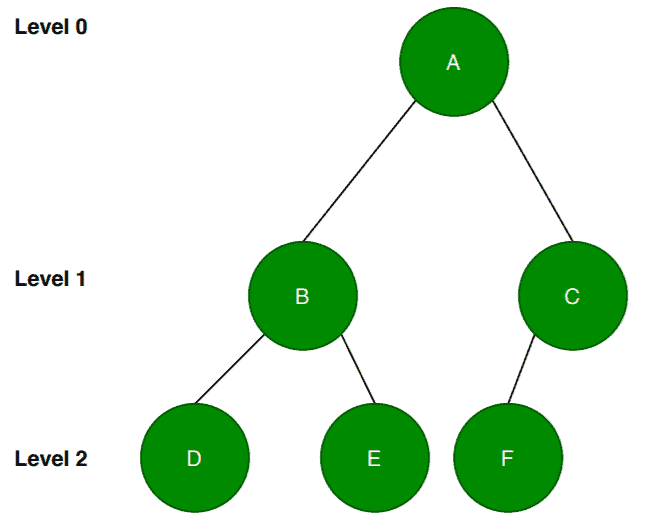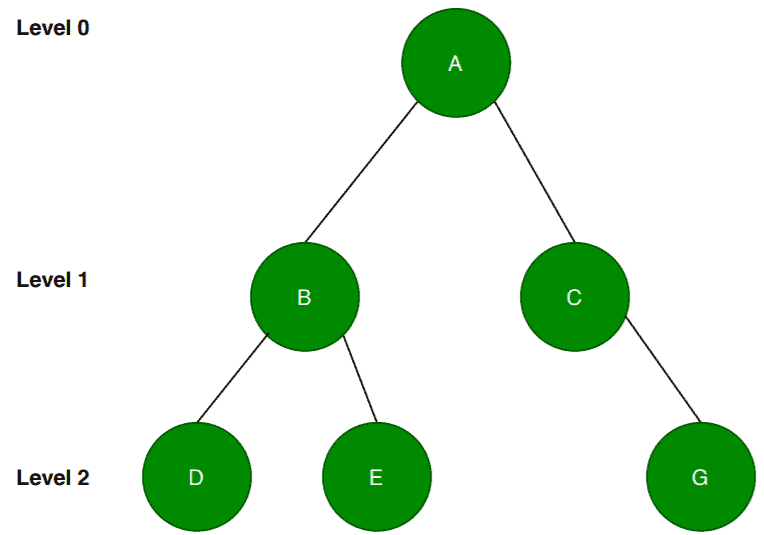1. 概述
在计算机科学中,二叉树是一种非常流行且广泛使用的数据结构。它由一个根节点、一个左子节点(或左子树)和一个右子节点(或右子树)组成。每个节点最多有两个子节点(不包括叶子节点),基于这一特性,可以衍生出多种变体。
在本文中,我们将重点讨论其中两种常见的变体:完全二叉树(Complete Binary Tree) 和 几乎完全二叉树(Almost Complete Binary Tree)。
2. 满二叉树(Full Binary Tree)
2.1 定义
在介绍完全二叉树和几乎完全二叉树之前,我们先回顾一下满二叉树的概念。
满二叉树是指:除了叶子节点外,每个内部节点都恰好有两个子节点。换句话说,所有叶子节点必须处于同一层级,且所有非叶子节点都有两个子节点。
2.2 示例
如下图所示,是一个典型的满二叉树:

图中每个非叶子节点都有两个子节点,且所有叶子节点(D, E, F, G)都处于同一层。
再来看另一个例子:

节点 C 是一个非叶子节点,但它只有一个子节点。这不符合满二叉树的定义,因此这不是一个满二叉树。
3. 完全二叉树(Complete Binary Tree)
3.1 定义
完全二叉树是一种特殊的二叉树,其定义如下:
- 所有层级(除最后一层外)必须完全填满;
- 最后一层的节点可以不满,但必须从左向右连续填充;
- 每一层的节点数应为 2^L(L 表示层级)。
⚠️ 一个关键点是:不能跳过左边节点而只填充右边节点。
3.2 示例
来看一个例子:

- 层级 0(根节点 A)有 1 个节点;
- 层级 1(B, C)有 2 个节点;
- 层级 2(D, E)有 2 个节点,且从左到右填充。
✅ 所有条件都满足,因此这是一个完全二叉树。
再看另一个例子:

- 层级 0 和 1 均满足;
- 层级 2 中,节点 B 没有子节点,而节点 C 有子节点。
❌ 这不符合“从左向右填充”的规则,因此这不是一个完全二叉树。
3.3 应用场景
完全二叉树在以下场景中非常常见:
- 堆(Heap)数据结构(最大堆、最小堆);
- 堆排序(Heap Sort)算法;
- 优先队列(如 Java 中的
PriorityQueue); - 外部排序算法(External Sorting)。
4. 几乎完全二叉树(Almost Complete Binary Tree)
4.1 定义
几乎完全二叉树是完全二叉树的一种特例,其定义如下:
- 插入节点必须按层进行,且每层必须从左向右插入;
- 最后一层不一定填满;
- 每一层(除最后一层外)节点数必须为 2^L;
- 所有内部节点必须完全填满;
- 几乎完全二叉树一定是完全二叉树,但完全二叉树不一定是几乎完全二叉树。
4.2 示例
来看一个例子:

这个树是之前满二叉树的例子中删除了节点 G 后的结果。
- 层级 0 和 1 满足完全填满;
- 层级 2 是最后一层,未完全填满;
- 所有节点从左向右填充。
✅ 因此这是一个几乎完全二叉树。
再看另一个例子:

节点 C 缺少左子节点,但有右子节点。
❌ 这违反了“从左向右填充”的规则,因此这不是几乎完全二叉树。
5. 完全二叉树 vs 几乎完全二叉树
| 参数 | 完全二叉树 | 几乎完全二叉树 |
|---|---|---|
| 定义 | 最后一层可能未满,但节点必须从左填充 | 最后一层一定未满,节点必须从左填充 |
| 性质 | 可能是或不是几乎完全二叉树 | 一定是完全二叉树 |
| 应用 | 堆结构、优先队列、排序算法 | 无特定应用,通常使用完全二叉树替代 |
6. 总结
本文详细介绍了以下三种二叉树类型:
- 满二叉树(Full Binary Tree);
- 完全二叉树(Complete Binary Tree);
- 几乎完全二叉树(Almost Complete Binary Tree)。
通过定义和示例对比,我们明确了:
- 完全二叉树允许最后一层未满,但必须从左填充;
- 几乎完全二叉树是完全二叉树的子集;
- 两者在堆结构等数据结构中有着广泛应用。
理解它们之间的区别有助于在实现堆、优先队列等结构时做出更合理的数据结构选择。